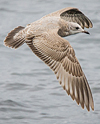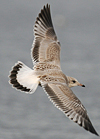 Mew Gull Larus canus canus; heinei; kamtschatschensis; brachyrhynchus
Mew Gull Larus canus canus; heinei; kamtschatschensis; brachyrhynchus
(last update: March 12, 2012)
Mew Gull (Larus canus) 1st cycle (1CY): September - October
Mew Gull is a widespread species on the northern hemisphere with several sub-species: in N America brachyrhynchus,
in W Europe nominate canus, in W Asia and Russia heinei and in the Far
East sub-species kamtschatschensis.
The American race brachyrhynchus is a breeding bird of
Alaska, the American West coast and inland Canada. After the
breeding season, it disperses south along the coast to California. Brachyrhynchus can be readily told from nominate canus, and therefore
sometimes considered a full species: Mew Gull. The differences can
be found in the bill (in some birds obviously small), but most in
plumage.
Nominate canus is a common breeding bird in North Europe, wintering both in the breeding area and slightly south, to the northern coast of the Mediterranean.
The race heinei breeds from White Russia eastwards to central
Mongolia, in a broad band over the tundra region of inland U.S.S.R.
It can be found wintering in the central Asian states, southern
Black Sea and Caspian Sea and further south to the Persian Gulf.
Part of the eastern population of heinei may follow a more
eastern route to the coast of China.
Race kamtschatschensis breeds in eastern Siberia and, as the
name indicates, Kamtschatcha. In winter it moves southwards along
the coast, wintering in Japan, the Korea's and China. It is the
largest race, almost as large as Herring Gull. The description below largely follows from P.J. Grant: "Gulls, a guide to identification".

Upperpart grey tone: |
||||
| delawarensis | 3-4(5) | Malling Olsen & Larsson | 4-5 | Howell & Dunn |
| canus | 5-6(7) | Malling Olsen & Larsson | 5-6.5 | Howell & Dunn |
| brachyrhynchus | 5.5-7.5 | Malling Olsen & Larsson | 6-7.5 | Howell & Dunn |
| heinei | 6-8 | Malling Olsen & Larsson | 5.5-7 | Howell & Dunn |
| kamtschatschensis | 6-9 | Malling Olsen & Larsson | 6.5-8 | Howell & Dunn |
1CY Mew Gull
In juvenile plumage, the forehead, throat and nape are white, with the ear-coverts and crown streaked. The streaks of the hind-neck often create a collar, running down the sides of the breast into mottled upper-breast and flanks. The belly and vent are white. In nominate canus, the upper-tail coverts and rump are white with ill-defined chevrons. The under-tail coverts are white as well, some with arrow-heads. The scapulars and mantle feathers are buffish-brown centred with a pale fringe, creating a scalloped effect. The tertials and inner three or four greater coverts are brownish centred as well, with a pale buff fringe. The central and outer greater coverts are more extensive grey-brown, although the feathers have dark shafts and wedge-shaped centres. The median coverts, lower lesser and lesser coverts have brown centres, a dark shaft and buffish fringe, creating a dark carpal bar, contrasting with the pale greater coverts. The dark secondaries create another dark bar on the upper-wing. The secondaries have a white trailing edge, running further onto the inner five primaries. The four to five inner primaries show pale inner-webs; the outer primaries and primary-coverts are all dark. The axillaries and under-wing coverts are white based with black tips, creating lines over the under-wing. The tail-band is clear-cut in nominate canus, with the outer tail-feathers largely white. In the race brachyrhynchus the base of the tail-feathers is mottled, looking completely dark from a distance. Brachyrhynchus has very obvious patterned juvenile upper-tail coverts.
The partial autumn moult (moult into so-called "first winter" plumage) includes the body and head feathers. This moult starts as soon as the nest is abandoned and continues to late September in nominate canus. The race heinei, which breeds on northern latitudes may appear all juvenile well into December. The head and breast are moulted to second generation feathers, most reminiscent of the juvenile feathers. The mantle and scapulars are moulted to plain grey second generation feathers in canus.
Brachyrhynchus in 1cy looks paler on average and more washed-out than nominate canus. In canus, the second generation scapulars and mantle feathers are plain grey; in brachyrhynchus, these feathers are often mottled pale brownish, lacking most of a grey tone. The differences between the two taxa become more striking in the first months of 2cy, when the complete wing looks faded in brachyrhynchus, washed brown, including the primaries. The tail will be brownish as well, lacking a clear-cut tail-band as in canus. Brachyrhynchus has the base of the tail-feathers mottled. In general, the upper-tail coverts, head, under-parts and rump are more uniform brown-grey.
"brachyrhynchus" Mew Gull 1CY Sept - October
 Mew Gull brachyrhynchus 1st cycle, September 28 2012, Sault Ste. Marie Landfill, US. Picture: Kirk Zufelt.
Mew Gull brachyrhynchus 1st cycle, September 28 2012, Sault Ste. Marie Landfill, US. Picture: Kirk Zufelt. Mew Gull brachyrhynchus 1st cycle (1CY), October 01 2016, Balaklava Island, BC., Canada. Picture: Ivan P. Dubinsky.
Mew Gull brachyrhynchus 1st cycle (1CY), October 01 2016, Balaklava Island, BC., Canada. Picture: Ivan P. Dubinsky. Mew Gull brachyrhynchus 1st cycle, October 31 2011, Virginia Lake. Picture: Kirk Zufelt.
Mew Gull brachyrhynchus 1st cycle, October 31 2011, Virginia Lake. Picture: Kirk Zufelt. Mew Gull brachyrhynchus 1st cycle (1CY), September 14 2014, Chesterman's Beach, Tofino, BC. Picture: Ilva Povalyaev.
Mew Gull brachyrhynchus 1st cycle (1CY), September 14 2014, Chesterman's Beach, Tofino, BC. Picture: Ilva Povalyaev. Mew Gull brachyrhynchus 1st cycle (1CY), October 14 2013, Rio del Mar, CA, USA. Picture: Jeff Poklen.
Mew Gull brachyrhynchus 1st cycle (1CY), October 14 2013, Rio del Mar, CA, USA. Picture: Jeff Poklen."canus" Mew Gull 1CY September - October
 Mew Gull canus 1CY, October 23 2016, Grou, the Netherlands.
Mew Gull canus 1CY, October 23 2016, Grou, the Netherlands. Mew Gull canus 1CY, October 19-23 2016, Grou, the Netherlands.
Mew Gull canus 1CY, October 19-23 2016, Grou, the Netherlands. Mew Gull canus 1CY, October 10 2012, Grou, the Netherlands. Picture: Ruurd Jelle van der Leij.
Mew Gull canus 1CY, October 10 2012, Grou, the Netherlands. Picture: Ruurd Jelle van der Leij. "heinei" Mew Gull 1CY September - October
"kamtschatschensis" Mew Gull 1CY Sept - October
 Mew Gull kamtschatschensis 1st cycle (1CY), October 29 2010, Choshi, Japan. Picture: Seichoudoku.
Mew Gull kamtschatschensis 1st cycle (1CY), October 29 2010, Choshi, Japan. Picture: Seichoudoku. Mew Gull kamtschatschensis 1st cycle (1CY), October 25 2007, Choshi, Japan. Picture: Seichoudoku.
Mew Gull kamtschatschensis 1st cycle (1CY), October 25 2007, Choshi, Japan. Picture: Seichoudoku. Mew Gull kamtschatschensis 1st cycle (1CY), October 30 2009, Choshi, Japan. Picture: Seichoudoku.
Mew Gull kamtschatschensis 1st cycle (1CY), October 30 2009, Choshi, Japan. Picture: Seichoudoku.